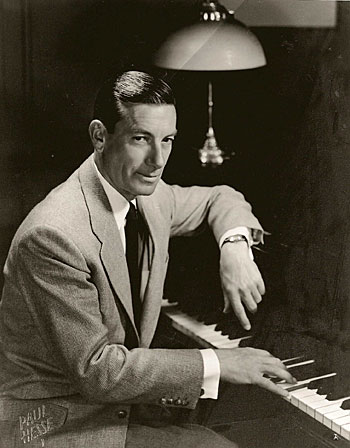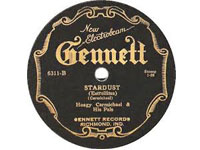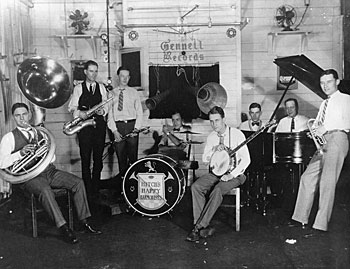Some time ago I was listening to a CBC Radio show hosted by Colin James, a great blues-based musician, who flatly declared that Stardust was the best song ever written. He did this just after playing a Howlin’ Wolf record which puts him in the Music Appreciation Hall of Fame as far as I’m concerned. There are many who would agree with him, unless you come from the generation that can’t see past Stairway to Heaven, Stardust is the hands-down best song ever.
How do we measure that? Statistics help, Stardust has been recorded about 1,500 times. That’s an astounding number but still less than Louie Louie which has racked up an estimated 1,600 recorded versions in a much shorter time and that’s not counting stuff being posted on YouTube every day. It’s a cultural phenomenon but nobody (while sober) thinks Louie Louie is the best song ever written.
Louie Louie succeeded because its simple structure appeals to musicians and the audience alike. Stardust succeeds because its complex structure does the same, with a far more profound impact.
 The song’s co- writer, Hoagy Carmichael, was also a complex person full of contradictions.
The song’s co- writer, Hoagy Carmichael, was also a complex person full of contradictions.
He was born in middle-America, Bloomington, Indiana, in 1899; the same year Scott Joplin released his Maple Leaf Rag which started the first popular music craze in America. His father was a migrant worker, barely able to provide for his family, his mother played piano at dances and movie theatres and had a golden oak piano in the house. She taught him to play ragtime but always told him that music was for fun, not a suitable profession. She named him Hoagland after a railroad baron because she wanted him to run a railroad some day.
He had the ambition to do it. As a child he dreamed of living in a big house on the hill in Bloomington and as a teenager he dated a rich woman, Dorothy Kelly, who lived in one. But he couldn’t let go of the music; he learned as much as he could and played anywhere he could find a piano. He also started booking bands and in 1919 after hearing a particularly good band from Louisville, Carmichael became a self-described “jazz maniac”. If you react strongly to music, you know the feeling.
He was still ambitious and studied law at Indiana University but according to his own memoirs, spent most of his time playing music and drinking, though he managed to get a law degree. It was around this time that he met legendary cornetist Bix Beiderbeck who encouraged him to write music. Carmichael wrote a song for him, Bix recorded it and, in Carmichael’s own words, “it threw my judgment out of kilter”. The romance ended, Hoagy forgot about the big house and dedicated himself to music.
He tried to go straight for a while and set up a law practice in Florida but when he accidentally heard that Red Nichols had recorded one of his songs from years ago, he gave up law and went back to music in Indiana.
The story goes that he wrote Stardust at this point while pining for his lost love, Dorothy, but that isn’t very likely. He wrote it as a mid-tempo jazz instrumental, not the love song it became. He wanted to make it sound like a cornet solo that Beiderbeck would have played and that is one part of its irresistible charm; while most up-beat dance tunes have a pretty basic, repetitive structure, the melody of Stardust meanders all over the place. It has a verse and a chorus that are melodically quite different from each other. According to his last biographer Richard Sudhalter, Carmichael had been working on the tune for years before he played it for his friend, Stuart Gorell (who later wrote the lyrics for Carmichael’s Georgia On My Mind) in 1927 and it was Gorell who said it was like “the dust from the stars drifting down through a summer night”. Carmichael then got some friends in a band together (which included the Dorsey Brothers), drove over to the Gennett recording studios in nearby Richmond, Indiana and recorded the song under the title Star Dust. He spelled it as two words because at the time there was no such word as “stardust” and nobody, including Carmichael, knew what the title meant, he just liked the sound of it.
 The record landed with a thud. When Carmichael came back to Gennett a year later wanting to record a new version with lyrics he had written, they said No Thanks.
The record landed with a thud. When Carmichael came back to Gennett a year later wanting to record a new version with lyrics he had written, they said No Thanks.
Meanwhile Carmichael moved to New York City and had a number of successes including Georgia, Rockin’ Chair and Lazy River, all of which were being recorded by the top names in the business.
He got a job at the Mills Publishing house in Tin Pan Alley and there met a young lyricist, Mitchell Parish. Parish was born Michael Pashelinsky to a Jewish family in Lithuania. He was brought up in New York’s Lower East Side and loved the music business but unlike Carmichael, was not really a jazz fan; he was more drawn to romantic poetry and Stephen Foster songs. Carmichael tried to get him to write lyrics for Star Dust but Parish didn’t like the song and wasn’t interested. According to an interview he gave with Mark Steyn, Parish only agreed to write the lyrics after he heard a new arrangement of the song by Victor Young of the Isham Jones Orchestra, who turned the bouncy dance tune into a slow, romantic ballad.
Parish had a set routine for writing lyrics; he would listen to the tune and then just think about it for a while. Sometimes he would write nonsense “dummy” lyrics in his head to get the rhythm and flow. After a few days he would take pen to paper but would stop writing after one hour because he didn’t want it to sound too worked over.
Mitchell Parish wrote lyrics that fit Stardust like a warm, woolen blanket. There is no set rhyme scheme because, like the melody, the lyrics flow like a narrative. The rhymes are peppered throughout, not at the ends of lines so it doesn’t sound forced. He only mentions the title obliquely in a couple of places, nothing is repeated. This is especially refreshing today when it seems popular song writing is about coming up with a clever phrase or hook and just repeating it over and over and over.
The new incarnation of Stardust was recorded (brilliantly) by Louis Armstrong and then by a very young Bing Crosby in 1931 but it still wasn’t a smash hit. Its popularity grew slowly and it didn’t become a standard until the 1940s when it seemed like absolutely everybody had to record it. Nat King Cole’s version may be the definitive one but then his version of any song usually turns out to be definitive. Once Nat sang a song, it was sung.
Carmichael moved to Hollywood and went on to tremendous success in movies and radio as well as on record; he was one of the first singer-songwriters in popular music.
Still, in later interviews he allowed that he wasn’t very happy and considered his life a failure. He may well have been happier in that big house in Bloomington but the rest of the music world is happy he gave us Stardust.

